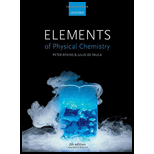
(a)
Interpretation:
For the given reaction, the standard Gibbs energy has to be calculated by calculating the standard reaction enthalpy and entropy.
Concept Introduction:
Standard Gibbs energy:
The relationship between Gibbs energy, enthalpy and entropy is given by,
(a)
Explanation of Solution
Given reaction,
Calculate the value of
Calculate the value of
Calculate the reaction Gibbs energy for the given reaction,
Therefore, the standard Gibbs energy of the given reaction is
(b)
Interpretation:
For the given reaction, the standard Gibbs energy has to be calculated by calculating the standard reaction enthalpy and entropy.
Concept Introduction:
Standard Gibbs energy:
The relationship between Gibbs energy, enthalpy and entropy is given by,
(b)
Explanation of Solution
Given reaction,
Calculate the value of
Calculate the value of
Calculate the reaction Gibbs energy for the given reaction,
Therefore, the standard Gibbs energy of the given reaction is
(c)
Interpretation:
For the given reaction, the standard Gibbs energy has to be calculated by calculating the standard reaction enthalpy and entropy.
Concept Introduction:
Standard Gibbs energy:
The relationship between Gibbs energy, enthalpy and entropy is given by,
(c)
Explanation of Solution
Given reaction,
Calculate the value of
Calculate the value of
Calculate the reaction Gibbs energy for the given reaction,
Therefore, the standard Gibbs energy of the given reaction is
(d)
Interpretation:
For the given reaction, the standard Gibbs energy has to be calculated by calculating the standard reaction enthalpy and entropy.
Concept Introduction:
Standard Gibbs energy:
The relationship between Gibbs energy, enthalpy and entropy is given by,
(d)
Explanation of Solution
Given reaction,
Calculate the value of
Calculate the value of
Calculate the reaction Gibbs energy for the given reaction,
Therefore, the standard Gibbs energy of the given reaction is
(e)
Interpretation:
For the given reaction, the standard Gibbs energy has to be calculated by calculating the standard reaction enthalpy and entropy.
Concept Introduction:
Standard Gibbs energy:
The relationship between Gibbs energy, enthalpy and entropy is given by,
(e)
Explanation of Solution
Given reaction,
Calculate the value of
Calculate the value of
Calculate the reaction Gibbs energy for the given reaction,
Therefore, the standard Gibbs energy of the given reaction is
Want to see more full solutions like this?
Chapter 5 Solutions
Elements Of Physical Chemistry
- Find the equilibrium concentration of H3O+ starting with 0.072 M solution of acetic acid. Ka = 1.8 x 10-5. Acetic acid is HC2H3O2 (aq).HC2H3O2 (aq) + H2O (l) ⇌ H3O (aq) + C2H3O2- (aq)arrow_forwardin VSEPR Theory AX2 isa) tetrahedralb) octahedralc) lineard) trigonal bipyramidarrow_forwardCheck How many signals would you expect to find in the H NMR spectrum of each given compound? Part 1 of 2 Part 2 of 2 Br Br 2. Cl X 2 © 2025 McGraw Hill LLC. All Rights Resarrow_forward
- true or false, enthalpy determines whether a reaction in endothermic or exothermicarrow_forwardCheck Consider the 13 C NMR spectrum below. 140 120 100 80 60 60 PPM 40 20 0 The spectrum belongs to which one of the following constitutional isomers of the compound C 10H14? Select the single best answer. ✓ Save © 2025 McGraw Hill LLC. All Rights Reserved.arrow_forwardThe structure of compound 1,1,2-trichloropropane is given below. Cl Cl Cl 1 How many signals would you expect to find in the 'H NMR spectrum of 1,1,2-trichloropropane? ×arrow_forward
- 1, How many signals do you expect in the H NMR spectrum for this molecule? Write the answer below. Also, in each of the drawing areas below is a copy of the molecule, with Hs shown. In each copy, one of the H atoms is colored red. Highlight in red all other H atoms that would contribute to the same signal as the H already highlighted red. Note for advanced students: In this question, any multiplet is counted as one signal. Number of signals in the 'H NMR spectrum. For the molecule in the top drawing area, highlight in red any other H atoms that will contribute to the same signal as the H atom already highlighted red. If no other H atoms will contribute, check the box at right. No additional Hs to color in top molecule For the molecule in the bottom drawing area, highlight in red any other H atoms that will contribute. to the same signal as the H atom already highlighted red. If no other H atoms will contribute, check the box at right. No additional Hs to color in bottom molecule Check…arrow_forwardIncorrect Row 2: Your answer is incorrect. Consider this molecule: How many H atoms are in this molecule? 22 How many different signals could be found in its 'H NMR spectrum? 12 Note: A multiplet is considered one signal.arrow_forward13 How many signals would you expect to see in the Check O signal(s) X § 'C NMR spectrum for the following compound? © 2025 McGraw Hillarrow_forward
 ChemistryChemistryISBN:9781305957404Author:Steven S. Zumdahl, Susan A. Zumdahl, Donald J. DeCostePublisher:Cengage Learning
ChemistryChemistryISBN:9781305957404Author:Steven S. Zumdahl, Susan A. Zumdahl, Donald J. DeCostePublisher:Cengage Learning ChemistryChemistryISBN:9781259911156Author:Raymond Chang Dr., Jason Overby ProfessorPublisher:McGraw-Hill Education
ChemistryChemistryISBN:9781259911156Author:Raymond Chang Dr., Jason Overby ProfessorPublisher:McGraw-Hill Education Principles of Instrumental AnalysisChemistryISBN:9781305577213Author:Douglas A. Skoog, F. James Holler, Stanley R. CrouchPublisher:Cengage Learning
Principles of Instrumental AnalysisChemistryISBN:9781305577213Author:Douglas A. Skoog, F. James Holler, Stanley R. CrouchPublisher:Cengage Learning Organic ChemistryChemistryISBN:9780078021558Author:Janice Gorzynski Smith Dr.Publisher:McGraw-Hill Education
Organic ChemistryChemistryISBN:9780078021558Author:Janice Gorzynski Smith Dr.Publisher:McGraw-Hill Education Chemistry: Principles and ReactionsChemistryISBN:9781305079373Author:William L. Masterton, Cecile N. HurleyPublisher:Cengage Learning
Chemistry: Principles and ReactionsChemistryISBN:9781305079373Author:William L. Masterton, Cecile N. HurleyPublisher:Cengage Learning Elementary Principles of Chemical Processes, Bind...ChemistryISBN:9781118431221Author:Richard M. Felder, Ronald W. Rousseau, Lisa G. BullardPublisher:WILEY
Elementary Principles of Chemical Processes, Bind...ChemistryISBN:9781118431221Author:Richard M. Felder, Ronald W. Rousseau, Lisa G. BullardPublisher:WILEY





